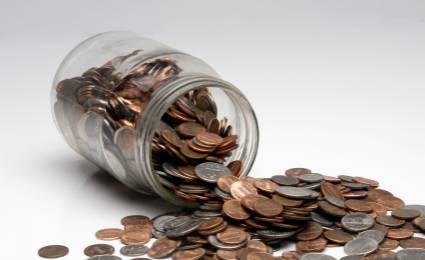Change For A Dollar
 If you have infinite pennies ($0.01), nickels ($0.05), and dimes ($0.10), in how many different ways can you make change for $1.00?
If you have infinite pennies ($0.01), nickels ($0.05), and dimes ($0.10), in how many different ways can you make change for $1.00?
Hint: Don't try to list all of the possibilities!
The answer is 121.
This section requires Javascript.
You are seeing this because something didn't load right. We suggest you, (a) try
refreshing the page, (b) enabling javascript if it is disabled on your browser and,
finally, (c)
loading the
non-javascript version of this page
. We're sorry about the hassle.
2 solutions
I figured that the solutions with no dimes is 21, and every dime added reduces that number by 2, so the answer is 1+3+5...+21=121
Why can't I figure out the number of ways to make change for a dime then use it as a permutation?
Meaning, for every 10 cents, you can either have a dime, two nickels, a nickel and five pennies, or ten pennies. 4 possibilities, 10 "slots" (to make them equal 100) means 4^10. I'm assuming it's wrong (it's not the given answer), but where is the reasoning wrong?
Log in to reply
Some of the possibilities you count several times.
Because making one 10cent out of two nickels and one 10 cent out of ten pennies is the same as making two 10cent out of one nickel and 5 pennies. 2 nickels and 10 pennies to make 20 cent will be counted twice. 10 nickels and 50 pennies to make 100cent will be counted many times.
How could you explain that P represent as 21-2d? Thanks
This is my way:
So I said: Let a=0.01, b=0.5, c=0.1 and n(c) how many dimes we have:
n(c)=0:
0
b+100
a AND
1
b+95
a AND
.
.
. AND
20
b+0
a
Which is 21 different combinations. Then say that n(c)=1 and find that there are 18 combinations and each time n(c) increases by 1 the number of combinations decreases by 2 until we get to a place where n(c)=10. So we a get a sum S=1+3+5+7+9+....+21=(11^2+11+10^2+10)/2=121.
I still don't get why it wouldn't allow me to have a lot or lots as an answer
Let d be the number of dimes, and n the number of nickles. For any choice of d and n such that 0 ≤ 1 0 d + 5 n ≤ 1 0 0 , the dollar is completed by adding just enough pennies.
- For d=0, we can choose n anywhere from 0 through 20 (21 ways)
- For d=1, we can choose n anywhere from 0 through 18 (19 ways)
- ...
- For d=9, we can choose n=0, 1 or 2 ( 3 ways)
- For d=10, the only option is to have n=0 (1 way)
The total number of ways then is 2 1 + 1 9 + . . . + 3 + 1 = 2 2 2 × 1 1 = 1 2 1 ways.
Let p , n , and d be the number of pennies, nickels, and dimes, respectively, used when making change. We want to determine the number of non-negative integer solutions to p + 5 n + 1 0 d = 1 0 0 . The first thing we note is that the change from the pennies, p = 1 0 0 − 5 n − 1 0 d = 5 ( 2 0 − n − 2 d ) , is divisible by 5. Thus, we write p = 5 P where P is a non-negative integer.
Our equation then becomes 5 P + 5 n + 1 0 d = 1 0 0 ⇒ P + n + 2 d = 2 0 . It is straightforward to see that the number of dimes, d , can range from 0 to 10. Then, P + n = 2 0 − 2 d , so P can be any of the ( 2 1 − 2 d ) values 0 , 1 , … , 2 0 − 2 d at which point n is uniquely determined as 2 0 − 2 d − P .
Thus, the total number of ways to make change is d = 0 ∑ 1 0 ( 2 1 − 2 d ) = 1 2 1 .